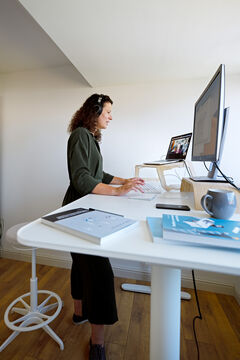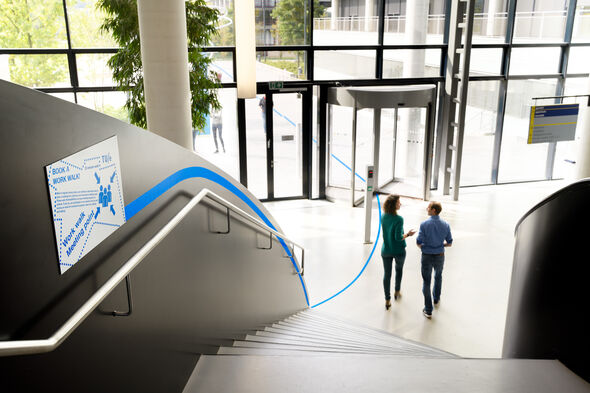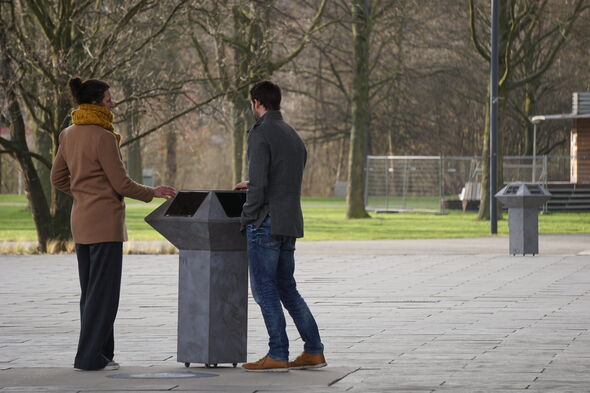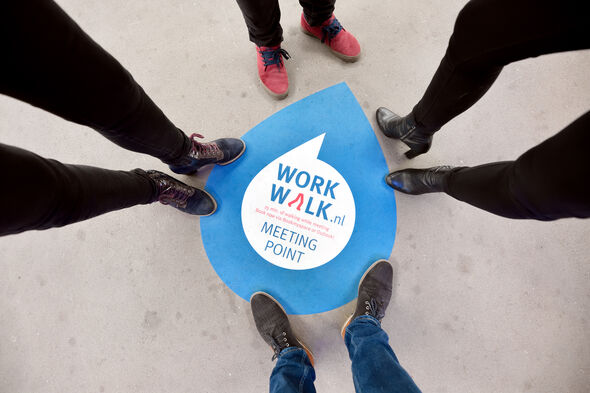Home Stretch | Become active at work
We spend too much time sitting down in the Netherlands. Student and office workers even spend no less than nine hours a day behind a desk. And that’s unhealthy, because sitting down too much and for too long can cause all kinds of health problems. That is why TU/e researcher Ida Damen encourages us to become active and came up with the WorkWalk. Apart from meeting and consulting while walking, she also looked into other ways to get office workers to become more physically active. She will obtain her PhD degree on Friday, December the 10th.
She would have preferred to do the Teams interview for this Home Stretch article while walking, Ida Damen admits with a smile. There is a serious undertone to her words though, because there are ways to also make working from home much more dynamic, the PhD candidate at Industrial Designs (ID) believes. “When you meet for the first time, it’s nice if you can look each other in the eye, which is why we are sitting behind our laptops now. But it’s very simple to have a walking teams meeting with colleagues you know well. In addition, you often get better ideas in a more quiet, creative surrounding – a bonus point, apart from the fact that you’re active. The only thing you need to think about, is to make sure that your phone battery is charged.”
When Damen, who has a background in human movement sciences, started her doctoral research four years ago, she observed her working environment with some amazement. “During my internships with the Knowledge Centre for Sport & Physical Activity and the Mulier Institute, I saw that physical activity had become integrated in the work culture. Desk bikes, working standing up, or going for a walk in the woods to have a brainstorm session, these things were perfectly normal to me. At TU/e however, I was assigned to a workstation where I had to sit behind: ‘this is your workplace where you’ll spend eight hours a day doing research into employee vitality.’ That came as quite a shock.”
She goes ahead and lists some facts and figures. The average office worker spends 9.3 hours per day sitting down, only 44 percent meet the physical activity guidelines issued by the Health Council of the Netherlands that they perform at least 150 minutes of moderate physical activity per week, and inactivity is the fourth leading risk factor for mortality in the world. Damen – a passionate researcher with a positive attitude – saw this as a challenge to make her workplace more dynamic. “Together with some students, we started to consider the possibilities. What kind of design can we use to encourage a discussion about a new way of working? How can we draw more attention to physical activity at the office? Currently, people mostly use their lunch break to exercise; I, on the other hand, would like to come up with ways to make people more active during their work.”
The explorations led to several designs. Desk chair Ivy, a co-project with fellow ID researcher Daphne Menheere, is covered with ivy branches. After two hours of uninterrupted sitting, the chair becomes overgrown. An alternative to the screens and beeping sounds to make you conscious of your sitting behavior, Damen explains. ID graduate student Ingmar Nieuweboer used 270 wooden rods and an elastic cord to build the impressive mathematical structure Office Jungle – for insiders: a rhombicosidodecahedron – that doesn’t just encourage people to adopt an active working posture, but also to jump and bounce around, as became apparent during the DDW21.
But Damen found a different way to get people at TU/e to become more active. If you keep your eyes fixed on the ground outside on the campus, you will see the by now familiar – and somewhat faded, after a few years – blue spots. These spots mark a two-kilometer-long blue line across campus that encourages employees and students to meet or consult with each other while walking, the central design of Damen’s successful project WorkWalk. “We want to pull employees away from the boring meeting rooms and get them to go outside, where they can meet and consult while they walk. Physical elements, such as the blue route and meeting signs, create extra visibility and some social acceptance. They also make sure that people keep their cellphones in their pockets. Having to constantly look up the time or the route on your screen as you also constantly keep getting new messages, distracts from the conversation you’re having.”
WorkWalk is a success within the TU/e community, Damen says enthusiastically. “Employees are positive about the changes in social dynamics during the walking meetings. It’s more informal and less hierarchical. Participants also tell us that they find it easier to remember things when they’re walking, that they are more actively involved in the conversation, and that they arrive at fresher ideas. Also nice: a professor used the walk for the weekly meeting with his students and says that it’s a fine time management tool. Once they arrive back at the front door after almost thirty minutes, it’s time to wrap things up.”
Because of the WorkWalk’s success, the project will be extended so that those who wish to walk and meet and the same time will soon have four routes to choose from on the TU/e campus. With lots of green, different lengths and easy combination alternatives, making it possible to opt for a walk that suits every imaginable meeting length. A welcome variation from all the screen work, Damen realized when she had to go through a recovery trajectory after a cycling accident last year. “Recovery centers and company physicians should also pay more attention to a dynamic working environment. Staring at a screen often makes people feel tired and overstimulated. A different approach to work can be extremely helpful, so that people will be able to return the work floor sooner.”
Damen is also working to overcome the often-raised objection that you can’t make notes or give presentations during walking meetings. “We’ve developed a network of ANWB mushroom-like interactive columns. People who make use of the WorkWalk can log in to these columns and present their data on the spot or make notes. We are going to test these hubs on the High Tech Campus, where researchers are also developing four meeting routes organized into themes.”
This way, Damen hopes to get more and more office workers to embrace the idea of walking meetings. And it works. Tilburg University – Damen is a former member of the Tilburg Sports Council in her city of birth – also created a route. In her new position at Fontys University of Applied Sciences, Damen will take a next step. Within the FITT project, she is currently working in the livinglab ‘Workplace Vitality Hub,’ located on the High Tech Campus. In addition, she wants to promote awareness of walking meetings among government agencies. We could all be more physically active, she emphasizes. “Take a critical look at your own agenda and ask yourself with each activity you undertake: can I do that in a different way? There are always moments during a work task when you can become active for a moment.”
Would you also like to start meeting while you walk? Book WorkWalk, with departure points near several TU/e buildings, via the platform Book My Space or Outlook.






Discussion